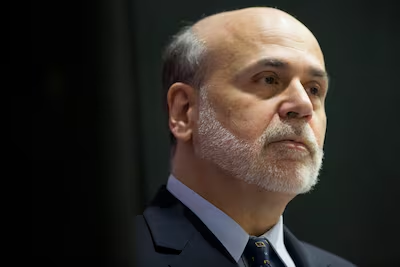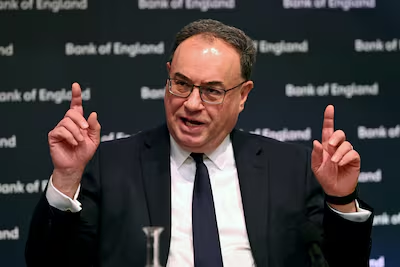The Bank of England’s main economic forecasting model needs a complete revamp, according to a review published on Friday by the former chairman of the US Federal Reserve.
Ben Bernanke’s review had 12 recommendations for the Bank of England that cover how it forecasts the future paths of interest rates and inflation and how it communicates views on the UK economy, including any uncertainties or risks that it might foresee, with the markets and the public at large.
“The forecasting and policy challenges faced by the Bank of England in recent years were hardly unique,” Mr Bernanke said.
“Still, they have served as a stress test of forecasting at the bank.
“The bank, like other central banks and policy institutions, will be working to draw the appropriate lessons from this experience. The goal of this review is to assist in this effort.”

Fan chart fail
Bank of England governor Andrew Bailey welcomed Mr Bernanke’s review, adding that it was a “once-in-a-generation opportunity to update our approach to forecasting, and ensure it is fit for our more uncertain world”.
Mr Bernanke recommended that the central bank publish more alternative scenarios for the economy when forecasting, rather than amalgamating market expectations of where inflation and rates might go into what is commonly called a “fan chart”.
Capital Economics
The term was coined by the Bank of England in 1997 and refers to a single line chart which then incorporates a number of different forecasted points, meaning the line “fans out” into the future.
Importantly, Mr Bernanke did not recommend so-called “dot-plot” method of forecasting, where rate setters anonymously publish their own forecasts for interest rates, growth and inflation.
It’s a method Mr Bernanke introduced when he was chairman at the Fed 12 years ago and continues to be in use there today.
But the Bank of England does not publish its own rate forecasts and Mr Bailey is known to be somewhat dismissive of the dot-plot method.
At the moment, the bank produces two sets of forecasts for inflation, growth and unemployment.
One is based on interest rates staying unchanged, and the other on what financial markets think will happen to borrowing costs over the next three years. The European Central Bank uses a similar approach.
But Mr Bernanke said that the Bank of England should be “exceptionally clear” when they believe market expectations for interest rates are “inconsistent with its view of the outlook”.

Unique circumstances
Mr Bernanke was given the task eight months ago of looking into the inner workings of the Bank of England and the interest rate decisions it made at the time inflation in the UK was rapidly rising in the aftermath of Russia’s invasion of Ukraine in early 2022.
Many economists have accused the bank of being too slow to raise rates when inflation was starting to soar and of currently being too slow to bring them back down now that UK economic growth is struggling.
In fairness, the inflation shock to energy prices in the wake of the Ukraine war caught many central banks by surprise, in a world that had enjoyed low borrowing costs for 10 years.
Mr Bernanke described the Bank of England's failure to foresee the surge in inflation as “probably inevitable” due to “unique circumstances”, although he stopped short of comparing its rate decisions in terms of other central banks, because that was not in his remit.
Economists often point to the Bank of England’s Monetary Policy Report in May 2022 as evidence that something was amiss. At the time, inflation in the UK was seven per cent and interest rates were at one per cent.
The bank’s Monetary Policy Committee believed a one per cent rise in interest rates would be enough to quell inflation and bring it back down to its 2 per cent target.
That is not what happened, and a series of rate rises over the following 15 months took rates to 5.25 per cent in August 2023, the level they remain at today.
Meanwhile, by October 2022 inflation had risen to a 40-year high of 11.1 per cent. By August 2023, it had fallen to 6.7 per cent and by February this year inflation was down to 3.4 per cent.
Rate cuts?
The trouble is many economists now think that interest rates have been too high for too long and that inflation will undershoot the Bank of England’s two per cent target within the next few months.
“Overall, this is a great opportunity for the bank to improve its forecasting and the way it communicates its views,” said Paul Dales, chief UK economist at Capital Economics.
“It’s a shame that it appears it won’t go the whole hog and publish projections for interest rates, although technically that hasn’t been ruled out.
“None of this will help the bank navigate the more pressing issue of when and how fast to cut interest rates.
“For what it’s worth, our view that inflation will be lower than the bank is forecasting implies it may cut interest rates from 5.25 per cent in June all the way to 3 per cent next year.”
Any changes to the bank’s forecasting methodology are predicted to take place slowly. Clare Lombardelli, who will join the Bank of England in July as deputy governor for monetary policy, will lead the implementation of any changes.





